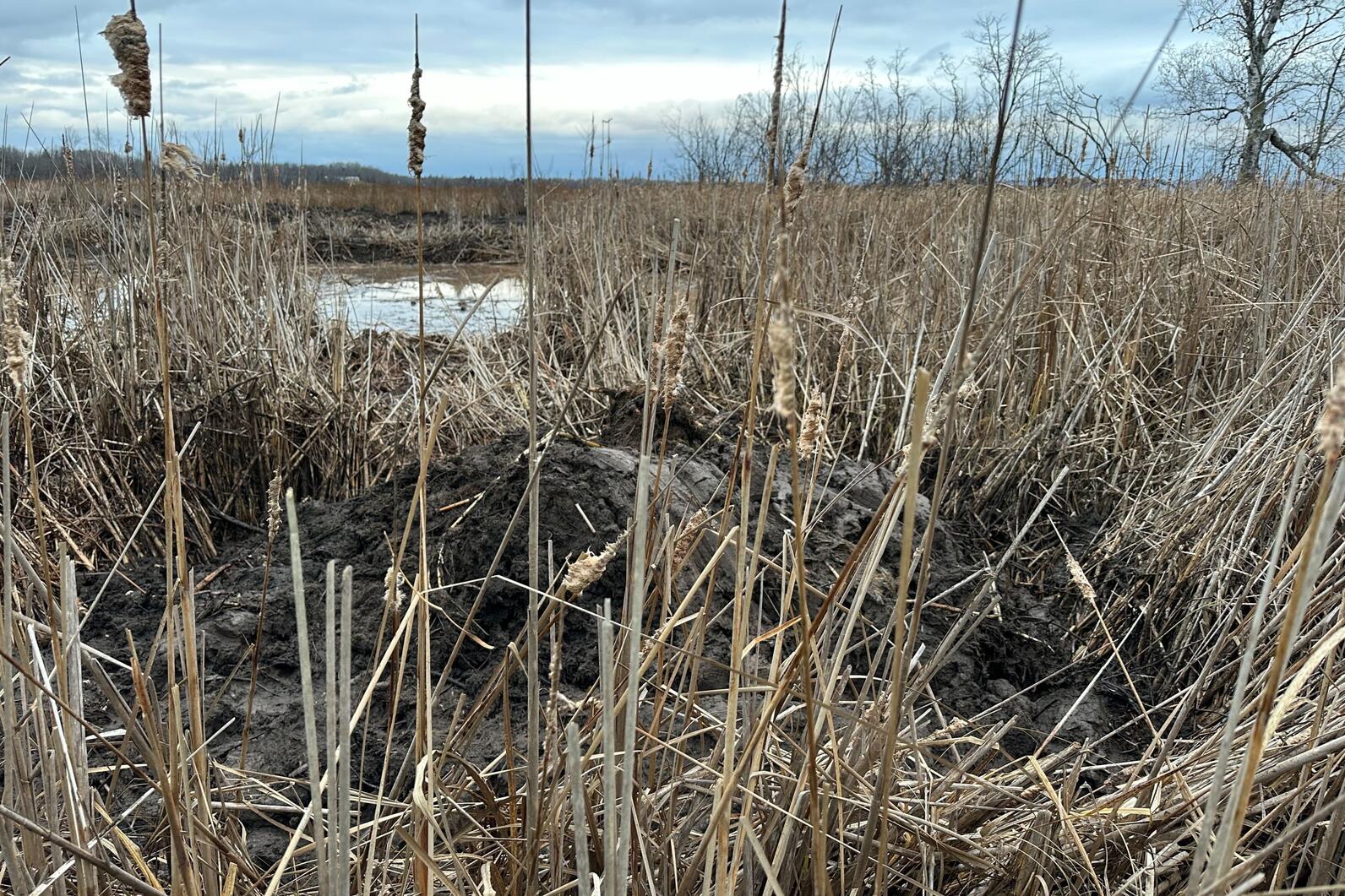Superior, WI – (November 25, 2024) – Audubon Great Lakes, in partnership with the Wisconsin Department of Natural Resources (DNR) and nearly a dozen local stakeholders, is excited to announce the commencement of the next phase of habitat restoration at Wisconsin Point in Allouez Bay, a critical Lake Superior coastal wetland within the St. Louis River Estuary. This project aims to transform the dense stands of invasive cattails (which act much more aggressively than the native broadleaf cattail) into a more diverse and dynamic marsh environment, supporting native wildlife by enhancing marsh bird, waterfowl, and fish habitat, and promoting ecological health.
Using a large amphibious excavator with large pontoon tracks to minimize disturbance, restoration crews will create channels and pools in areas overrun by invasive cattails, introducing variable hemi-marsh--a balanced habitat that combines pockets of open water and pockets of emergent vegetation with an ideal ratio of 50-50--conditions ideal for focal marsh bird species such as the Virginia Rail, Sora, American and Least Bitterns, and Pied-billed Grebe, species which are experiencing declining populations in the Great Lakes.
The design features the use of habitat mounds and muskrat mimic dens with the spoils from excavating to be placed in areas of dense invasive cattail to further diversify the structure of the wetland. These features are incorporated into the design because marsh birds and other wildlife use them for foraging, resting, and sometimes nesting. Currently, the areas where work is occurring are dominated by dense cattail growth, which limits biodiversity and access to open water. The cattail is spreading into a high-quality native wetland and a major goal of this restoration is to slow the advancement of this cattail into the high-quality habitat.

“By cutting channels and pools through dense cattail stands, connecting them to natural small inlets in the bay, we’re creating hemi-marsh habitat, which supports both native marsh birds and aquatic species,” said Tom Prestby, Conservation Manager at Audubon Great Lakes. “The diverse nature of hemi-marsh habitat supports many more species of birds and other wildlife, including fish, than the monoculture that invasive cattail stands create, thereby promoting a healthy ecosystem.”
An earlier phase of the project involved manually mowing and cutting cattails, and now these areas will be seeded with a custom seed mix developed in collaboration with local botanists, before the onset of winter. The seeds will work their way into the soil during the freeze and thaw cycles of winter and be ready to germinate next spring and summer. This strategic approach ensures long-term ecological benefits by giving native species a competitive edge against invasive cattails, to the most extent possible.

“This project represents a significant step forward in restoring the Wisconsin portion of the St. Louis River Estuary,” said Andy Hinickle, Senior Manager Wetland Conservation for Audubon Great Lakes. “Our goal aligns with preserving the health of coastal wetlands on Lake Superior, which are vital not only to the environment but also to cultural value and local use and recreation.”
By diversifying these areas that have turned into a jungle of invasive cattail, the project also increases recreational and enjoyment opportunities for residents of the City of Superior and other nearby communities, as well as tourists benefiting the local economy. Whether for birdwatching, fishing, hunting, gathering, or connecting with nature, this enhanced habitat provides an inviting space for the community to enjoy.
The restoration effort is a testament to collaborative conservation, bringing together state and local agencies, tribal partners, and environmental organizations from Wisconsin and Minnesota to ensure the long-term health of the estuary's wetlands.
A critically important area for the region’s breeding and migratory birds, loss of quality wetland habitat in Allouez Bay and throughout the St. Louis River Estuary region has contributed to the region’s decline of vulnerable marsh bird species. Black Terns, a species that was once common and has now declined drastically in the region, have not bred in the estuary since the 1990s.

The St. Louis River Estuary, an Audubon Important Bird Area (IBA) in Wisconsin and Minnesota, has suffered from a legacy of industrial pollutants and habitat loss, and was once one of the most polluted waterways in the United States. It is therefore listed as an Area of Concern (AOC). Despite this, many of the marshes that do remain are in relatively high-quality condition, supporting exceptional bird diversity during migration and nesting seasons. More than 240 bird species have been recorded within the estuary, and its numerous bays, islands, wetlands, barrier beaches, and forested areas provide diverse habitat for breeding marsh birds and birds that are migrating through the area. However, many of the coastal wetlands including Allouez Bay have suffered habitat degradation in large portions of the wetland, making restoration projects like this important for birds, other wildlife, fish, and people.
Temporary signage including a map of construction areas is posted at Lot 1 of Wisconsin Point until construction activities ends in December. This project is funded by the Great Lakes Restoration Initiative. Learn more about the project and partners here.
Media Contact: Nicole Minadeo, Director of Communications, nicole.minadeo@audubon.org.
About Audubon Great Lakes
Audubon Great Lakes is a regional office of Audubon, learn more at gl.audubon.org and follow us on Facebook, Twitter and Instagram.
The National Audubon Society protects birds and the places they need, today and tomorrow. Audubon works throughout the Americas using science, advocacy, education, and on-the-ground conservation. State programs, nature centers, chapters, and partners give Audubon an unparalleled wingspan that reaches millions of people each year to inform, inspire, and unite diverse communities in conservation action. A nonprofit conservation organization since 1905, Audubon believes in a world in which people and wildlife thrive.









